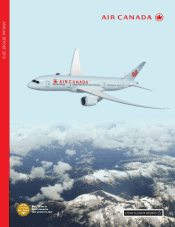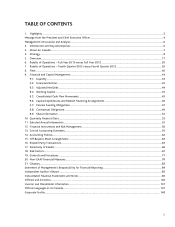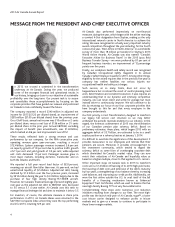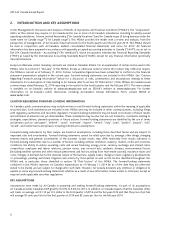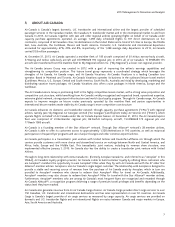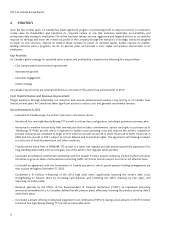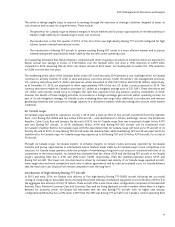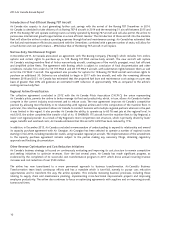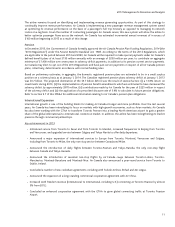Air Canada 2013 Annual Report Download - page 5
Download and view the complete annual report
Please find page 5 of the 2013 Air Canada annual report below. You can navigate through the pages in the report by either clicking on the pages listed below, or by using the keyword search tool below to find specific information within the annual report.
5
We also introduced four new Boeing 777 aircraft with a higher
seat density, reducing unit costs, and a Premium Economy cabin
that creates additional revenue opportunities. Additionally, fleet
rationalization continued as we transferred our EMBRAER 175
aircraft to a lower-cost regional carrier as part of a broader
strategy to diversify regional flying. Further fleet changes are to
continue in 2014 when we are due to start accepting delivery of
Boeing 787 Dreamliners that will operate routes currently flown
by less-efficient Boeing 767s.
These measures are the key drivers to an expected 15 per cent
reduction in unit costs when compared to 2012, assuming that
all other cost drivers remain at 2012 levels. Air Canada aims to
realize this 15 per cent reduction in unit costs over the next five
years.
Our second priority is Customer Engagement. While Air Canada
regularly wins numerous awards for its service and again
reported improved satisfaction levels in monthly customer
surveys in 2013, we remain very focused on excelling in this area.
This is not only necessary to maintain engagement, but also to
anticipate and respond to changing customer expectations and
increasing competition.
Among other initiatives during the year was the introduction of
Premium Economy class on select Boeing 777 aircraft that will
become more widely available with the arrival of our
Dreamliners. We also reformulated our loyalty program and
rebranded it as Air Canada Altitude™ to better align rewards
with travel. Operational programs were implemented as well to
improve the travel experience for customers, such as the
creation of a cross-functional team dedicated to increasing on-
time-performance that yielded double-digit improvements.
We anticipate customer satisfaction levels will be further
bolstered with the arrival of Dreamliners into the fleet as these
aircraft deliver a superior travel experience. In a similar vein,
Air Canada also placed an order in 2013 for 61 Boeing 737 MAX
aircraft, which, subject to completion of final documentation
and other conditions, will replace our existing fleet of narrow
body aircraft, with deliveries scheduled to begin in 2017, giving
us one of the youngest fleets in North America. Looking ahead,
Air Canada is introducing a customer-centric relationship
management system to gather customer feedback that will help
guide future engagement activities.
Recognizing that an engaged workforce is essential to the
sustainability of any company where high standards of
customer service are essential, our third priority, Culture Change,
is aimed at ensuring our people have the right mindset, training
and tools. We are fostering an environment that embraces
leadership, accountability and entrepreneurship. Moreover, we
continue to build on our existing programs and rewards to
attract, engage, and retain the right talent.
In 2013, we started or expanded a number of training programs
including a new on-board service program, a special Disney
customer-service course for Air Canada rouge™ flight
attendants, leadership training, additional French language
training, online courses and a very extensive suite of new
programs throughout all operational branches in preparation for
the Dreamliner’s arrival. Such programs have the beneficial
effect of enhancing the skills of our employees, which also
fosters employee engagement by demonstrating our
commitment to invest in their future. Moreover, employees take
pride in new aircraft types entering the fleet and the launch of
new routes.
Commitment can also be expressed in other forms, such as
being active through the company in one’s community, which
Air Canada Foundation encourages with an active employee
component. And it is not only local communities that are
benefitting. For example, through a matching donation program
with the Air Canada Foundation and the Government of Canada,
more than $200,000 was donated to the Canadian Red Cross on
behalf of Air Canada employees and retirees to assist victims of
Typhoon Haiyan in the Philippines.
The progress we are making on Culture Change is being
recognized outside the company. In 2013, Air Canada was
named one of Canada’s Top 100 Employers from an initial list of
75,000 potential candidates. Each month, we receive 110,000
hits on our career page, and for every Air Canada job we fill,
more than 100 people apply.
Our fourth priority is building an International Powerhouse. In
addition to launching service to Istanbul and Seoul from Toronto
in 2013, we announced an impressive list of new and expanded
international routes and destinations to start in 2014. Among
these is service between Toronto and Milan, Toronto and Tokyo-
Haneda as well as enhanced service between Calgary and
Tokyo-Narita to offer daily departures.
We also announced our intention to introduce seasonal, non-
stop flights by Air Canada rouge™ from Toronto to Lisbon and
Manchester and from Montreal to Barcelona and Nice in 2014.
We also plan to offer a year-round service from Toronto to
Dublin on Air Canada rouge™. Moreover, we have implemented
capacity increases to existing destinations operated by
Air Canada mainline from other Canadian hubs.
Key to our strategy is capturing global traffic flows by
promoting our award-winning products and services to entice
international travelers to fly Air Canada and connect through
Canadian hubs, particularly Toronto. In 2013, we concluded an
enhanced cooperation agreement with the Greater Toronto
Airports Authority to grow global connecting traffic at Toronto.
During the year sixth freedom revenue (international-to-
international connections, including U.S.) at Toronto Pearson
rose almost 3 per cent over 2012.
In conclusion, 2013 was a year of substantial achievement in
which we produced record results and moved beyond simply
managing some key challenges to actually establishing a
foundation for sustainably strong results. This made it truly a
watershed year in our ongoing transformation. But the long-
term, sustained profitability we seek is not a destination; it is
instead a condition that we must first achieve and then
proactively maintain through ongoing, disciplined adherence to
our priorities, as well as through innovation, adaptability,
resilience and an ability to recognize and seize opportunity,
taking measured risks where necessary.
I wish to thank our employees who work hard each day taking
care of our customers and delivering them safely to their
destinations. As well, thank you to our customers, shareholders,
suppliers and other partners for their loyalty and support. It is
our commitment to fulfill your expectations by building a
stronger, sustainably profitable Air Canada.
Calin Rovinescu
President and Chief Executive Officer

